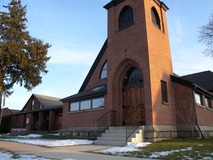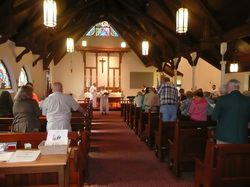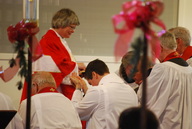WHAT TO EXPECT AT ST. JAMES' EPISCOPAL CHURCH

YOU ARE WELCOMED
We extend a warm welcome to worship with us and offer this brief introduction to St. James' Episcopal Church and its style of worship.
OUR WORSHIP SERVICES
Our worship services center around the celebration of The Holy Eucharist. The Holy Eucharist has two parts:
The Word of God and The Holy Communion.
The Word of God is based upon Jewish synagogue worship at the time of Jesus and consists of prayers, scripture readings, a sermon or homily, an affirmation of our faith (the Apostles’ or Nicene Creed), Prayers of the People, the Confession of Sin, and exchanging of the peace.
The Holy Communion is a commemoration of the Last Supper during which communion is distributed. At St. James' we use hosts and wafers and receive wine from a common cup, either directly or via intinction.
We believe that you will find the services of the Episcopal Church beautiful in their dignity and God-centeredness, while being mindful of the nature and needs of human beings.
THE ACT OF WORSHIP
Episcopal worship services actively involve the congregation through the recitation of certain portions of the service as found in The Book of Common Prayer. A bulletin is provided for the worship service containing the Scripture readings, the layout of the service including page numbers and hymn numbers and announcements. Each pew contains at least one Bible, Book of Common Prayer and a Hymnal..
You may wonder when to stand, kneel, or sit. The general rule is to stand to sing and praise, sit to listen, and kneel or stand, to pray. The appropriate posture is usually announced..
We stand to sing hymns and canticles (found in the blue hymnal in the pew racks). We also stand to recite the affirmation of our faith, the Apostles’ or Nicene Creed, and for the reading of the Holy Gospel.
We sit during the readings from the Old Testament and New Testament writings other than the Gospels.
The customary posture used during the Prayers of the People and the Eucharistic Prayer is to kneel as an act of humility before God, although standing for prayer is also appropriate. Kneeling is the most appropriate posture for the Confession of Sin.
One final note about these postures. If you are unable to kneel please feel free to stand or sit. The same is true of standing for any length of time. The intent of these postures is to reflect the attitude of our heart in the presence of God.

OUR PLACE OF WORSHIP
As you enter the church you will notice its natural beauty and an atmosphere of warmth, holiness, and reverence.
Rebuilt in 2010 after a fire, St. James' is laid out in a Victorian church style with two rows of pews facing the front of the church or sanctuary, choir stalls and a third row of short pews on the west side of the Nave and beautiful traditional stained glass windows.
In our sanctuary are an altar and a cross. These two symbols remind us that we are in God’s house and are intended to help us focus our attention on God’s redemptive love in Jesus Christ.
The altar sits at the front of the sanctuary and is the table from which the second half of the service is conducted and Holy Communion is administered. The two candles on the altar remind us that Christ is “the light of the world” (John 8:12).
During the Easter and Christmas season and funerals the Paschal Candle stands to the left of the Altar in celebration of Christ’s resurrection. At other times the Paschal Candle stands by the baptismal font at the back of the church.
The cross that hangs behind the altar is called a Crucifix, because it carries a figure of the crucified Jesus Christ.
Flowers or natural arrangements often adorn the retable as an offering from God’s creation to beautify God’s house.
On the right side at the front of the church is a lectern from which the Holy Scriptures are read. The pulpit is located on the left side of the front of the church and may be where the preacher proclaims the Word of God in a sermon.
Altar rails run along the step in front of the altar before which people stand or kneel when receiving communion.
As you enter the church you will notice its natural beauty and an atmosphere of warmth, holiness, and reverence.
Rebuilt in 2010 after a fire, St. James' is laid out in a Victorian church style with two rows of pews facing the front of the church or sanctuary, choir stalls and a third row of short pews on the west side of the Nave and beautiful traditional stained glass windows.
In our sanctuary are an altar and a cross. These two symbols remind us that we are in God’s house and are intended to help us focus our attention on God’s redemptive love in Jesus Christ.
The altar sits at the front of the sanctuary and is the table from which the second half of the service is conducted and Holy Communion is administered. The two candles on the altar remind us that Christ is “the light of the world” (John 8:12).
During the Easter and Christmas season and funerals the Paschal Candle stands to the left of the Altar in celebration of Christ’s resurrection. At other times the Paschal Candle stands by the baptismal font at the back of the church.
The cross that hangs behind the altar is called a Crucifix, because it carries a figure of the crucified Jesus Christ.
Flowers or natural arrangements often adorn the retable as an offering from God’s creation to beautify God’s house.
On the right side at the front of the church is a lectern from which the Holy Scriptures are read. The pulpit is located on the left side of the front of the church and may be where the preacher proclaims the Word of God in a sermon.
Altar rails run along the step in front of the altar before which people stand or kneel when receiving communion.

ABOUT RECEIVING COMMUNION
Consistent with the National Episcopal Church, all baptized Christians are invited to join us at the Lord's Table. To participate in communion, come forward as directed by the ushers. The most common Episcopal method of receiving communion is to present your hands, palms up, and one hand on top of the other in front of you so the clergy can place the bread in your hands. When presented with the chalice (a silver or gold goblet) the recipient may take hold of the base of the chalice, guiding it to the lips to control the amount of wine received. Intinction, or dipping the bread in the wine is practiced by a number of St. James' congregants. Gluten free wafers are available on request. Please cross your arms over your chest for a blessing.
Receiving communion of bread only or wine only is just as beneficial as receiving Holy Communion in both forms.
In our celebration of the Eucharist, we believe God’s grace is given to all people, you are invited to join us at the altar: seekers, doubters, believers, the young, the old and those in-between. Through the power of Jesus Christ, this is the altar prepared by a loving God for all of creation. As a part of that creation, you are welcome. So come to the Table. Come.
Consistent with the National Episcopal Church, all baptized Christians are invited to join us at the Lord's Table. To participate in communion, come forward as directed by the ushers. The most common Episcopal method of receiving communion is to present your hands, palms up, and one hand on top of the other in front of you so the clergy can place the bread in your hands. When presented with the chalice (a silver or gold goblet) the recipient may take hold of the base of the chalice, guiding it to the lips to control the amount of wine received. Intinction, or dipping the bread in the wine is practiced by a number of St. James' congregants. Gluten free wafers are available on request. Please cross your arms over your chest for a blessing.
Receiving communion of bread only or wine only is just as beneficial as receiving Holy Communion in both forms.
In our celebration of the Eucharist, we believe God’s grace is given to all people, you are invited to join us at the altar: seekers, doubters, believers, the young, the old and those in-between. Through the power of Jesus Christ, this is the altar prepared by a loving God for all of creation. As a part of that creation, you are welcome. So come to the Table. Come.
MUSIC
Music is an integral part of worship in the Episcopal Church. Hymns are accompanied by our piano or organ. Special music is provided during the year by our musicians and guest musicians.
BEFORE AND AFTER SERVICES
It is customary upon entering church to kneel in one’s pew for a prayer of personal preparation for worship. It is also appropriate to bow to the cross or altar on entering and leaving the pew as an acknowledgement of God’s presence.
Upon entering the church before a worship service everyone is asked to remain quiet and use this time for personal meditation and devotions. At the end of the service some people kneel for a private prayer before leaving. Others sometimes sit to listen to the closing organ voluntary. And yet others choose to leave immediately after the dismissal.
VESTMENTS
To add to the beauty and festivity of our services, and to signify their special role as liturgical ministries, the clergy and other leaders of a worship service wear vestments.
Servers at the altar wear white or flax (ivory) colored albs (gowns).
Ordained ministers wear a white alb. Over it they wear a stole (a narrow band of colored fabric) and a Eucharistic vestment. The deacon wears a dalmatic over the alb and stole in the color of the season or day. The priest wears a chasuble (a poncho like garment) over his or her alb and stole in the color of the season or day.
Music is an integral part of worship in the Episcopal Church. Hymns are accompanied by our piano or organ. Special music is provided during the year by our musicians and guest musicians.
BEFORE AND AFTER SERVICES
It is customary upon entering church to kneel in one’s pew for a prayer of personal preparation for worship. It is also appropriate to bow to the cross or altar on entering and leaving the pew as an acknowledgement of God’s presence.
Upon entering the church before a worship service everyone is asked to remain quiet and use this time for personal meditation and devotions. At the end of the service some people kneel for a private prayer before leaving. Others sometimes sit to listen to the closing organ voluntary. And yet others choose to leave immediately after the dismissal.
VESTMENTS
To add to the beauty and festivity of our services, and to signify their special role as liturgical ministries, the clergy and other leaders of a worship service wear vestments.
Servers at the altar wear white or flax (ivory) colored albs (gowns).
Ordained ministers wear a white alb. Over it they wear a stole (a narrow band of colored fabric) and a Eucharistic vestment. The deacon wears a dalmatic over the alb and stole in the color of the season or day. The priest wears a chasuble (a poncho like garment) over his or her alb and stole in the color of the season or day.
THE CHURCH YEAR
The Episcopal Church observes the traditional Christian calendar. The Church Year begins with the season of Advent (purple) on the Sunday closest to November 30 and continues until Christmas Eve.
Christmas (white) is not only celebrated on December 25 (or Christmas Eve) but for the twelve days after Christmas.
Epiphany, January 6, (white) begins the next season of the Church Year and lasts until Ash Wednesday. The color for this season is green.
Ash Wednesday is the beginning of Lent (purple). This is the time set aside (forty days) for an examination of our lives in preparation to celebrate Easter.
Easter (white) is the celebration of the resurrection of Jesus Christ. The Easter celebration lasts for fifty days.
Pentecost Sunday (red) is the celebration of the coming of the Holy Spirit. The next Sunday is Trinity Sunday (white). The rest of the year is the season after Pentecost (green).
We hope that you have found this information helpful and will join us in our worship and praise of God.
The Episcopal Church observes the traditional Christian calendar. The Church Year begins with the season of Advent (purple) on the Sunday closest to November 30 and continues until Christmas Eve.
Christmas (white) is not only celebrated on December 25 (or Christmas Eve) but for the twelve days after Christmas.
Epiphany, January 6, (white) begins the next season of the Church Year and lasts until Ash Wednesday. The color for this season is green.
Ash Wednesday is the beginning of Lent (purple). This is the time set aside (forty days) for an examination of our lives in preparation to celebrate Easter.
Easter (white) is the celebration of the resurrection of Jesus Christ. The Easter celebration lasts for fifty days.
Pentecost Sunday (red) is the celebration of the coming of the Holy Spirit. The next Sunday is Trinity Sunday (white). The rest of the year is the season after Pentecost (green).
We hope that you have found this information helpful and will join us in our worship and praise of God.
